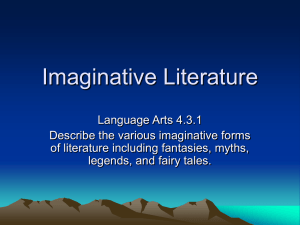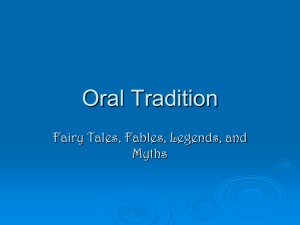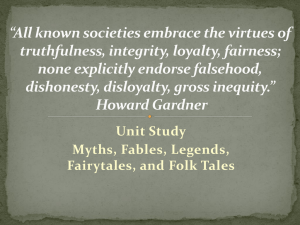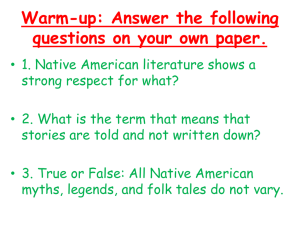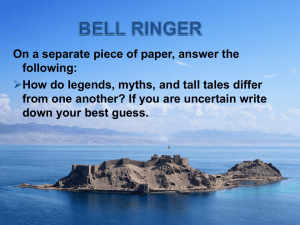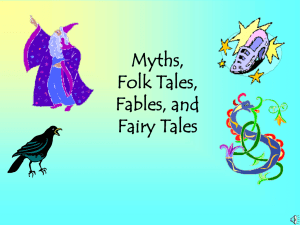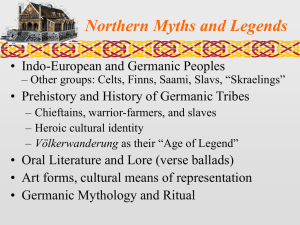Myths, Legends, Fables and Folktales
advertisement
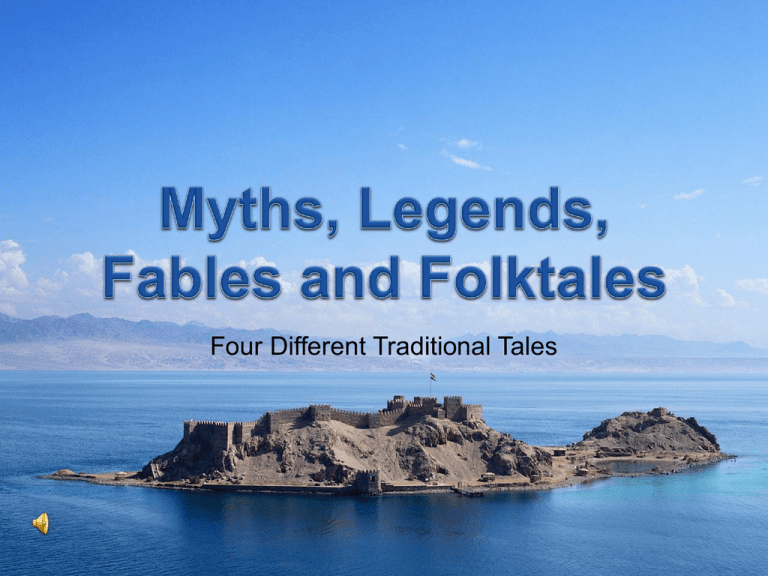
Four Different Traditional Tales Myths are stories that try to explain how our world works and how we should treat each other. They are usually set in times long ago, before history as we know it was written. People have always asked questions like “How did our world come to be?” or “Why is the ocean blue?” Some myths answered these questions. In other myths, gods or “super-beings” used their powers to make events happen. These myths described people and the choices they made. They might be about victory (achieving something), tragedy (losing something), honor (doing the right thing), being brave even when you are frightened, or being foolish and making mistakes. Heroes, gods and goddesses could help them or make things more difficult for them. Around the world, myths were shared by different groups of people and became part of their culture. Storytellers passed the stories on from generation to generation. Some similar myths were told in many cultures, but with variations in the events or characters. For example, most cultures, tribes or other groups of people had their own version of how our world began. For early people, myths were like science because they explained how natural events work. However, these stories were made up and are not really true. “Myth” comes from the Greek word “mythos” which means “word of mouth”. Examples of mythical characters include the Greek god Zeus and the Viking god Thor. Legends are also fictional stories, but they are different from myths. Myths are about how the natural world works, and are set in an ancient time. Legends are based on real people who lived in more recent times and are mentioned in history. Legends are told for a purpose and are based on facts, but they are not completely true. Either the person never really did what the story says, or the historical events were changed. The purpose was to make the story more interesting or convincing, or to teach a lesson, like knowing right from wrong. Like myths, legends are passed down from generation to generation. Examples of people in English legends are King Arthur and Robin Hood. A man who could have been King Arthur is known to have lived in the 5th or 6th century, but the stories of the Knights of the Round Table and Merlin the Magician are probably not true. The point was that knights and their king defended and helped their people. The character and deeds of Robin Hood may have been based on someone else. Robin of Loxley lived in Nottinghamshire around the time of the story, and he did help the poor. However, did he live in Nottingham forest with a band of robbers? Probably not, but helping other people is important and the legend hasn’t been forgotten. Today people use the word ‘legend’ in a different way when they talk about people and their deeds. They may describe an athlete as a “sporting legend”, or an actor as a “film legend”. What they mean is the person is famous because of their skills or things they have done. Urban legends are intriguing stories that aren’t true but could be possible A fable is another type of story, also passed down from generation to generation and told to teach a lesson about something. A fable usually ends with a moral, or a short sentence with a lesson about life. Fables are often about animals, plants, and natural forces like thunder or wind, that can talk and act like people. The most famous fables were written by a man from ancient Greece called Aesop. We know them as Aesop’s Fables, and he wrote more than 600 of them. The story of The Tortoise and the Hare was written by him. Folk and fairy tales are stories written specially for children, often about magical characters such as elves, fairies, goblins and giants. Sometimes the characters are animals. Some folk tales were passed down orally before being written. Hans Christian Andersen is famous for writing fairy tales. He was born in Denmark in 1805. Examples of his stories are “The Little Mermaid”, “Thumbelina,” “The Ugly Duckling,” and “The Red Shoes.” In Copenhagen there is a statue of the little mermaid, sitting on a rock on the beach at the harbor, in memory of the writer. Jacob and Wilhelm Grimm were brothers, born in Germany in 1785 and 1786. They are famous because they collected together many old fairy tales from different parts of Germany and wrote them down for people to read. We know them as the Brothers Grimm and their collection includes “Cinderella,” “Snow White,” and “The Frog Prince”. Myths and legends are old stories told for adults and children. Many were not written down until recently. Both are fictional, but legends are based on some fact. Fables were written for adults and children. Many were written by the Greek writer Aesop. Folk or fairy tales were written specially for children. Some were told orally before they were written. The End
